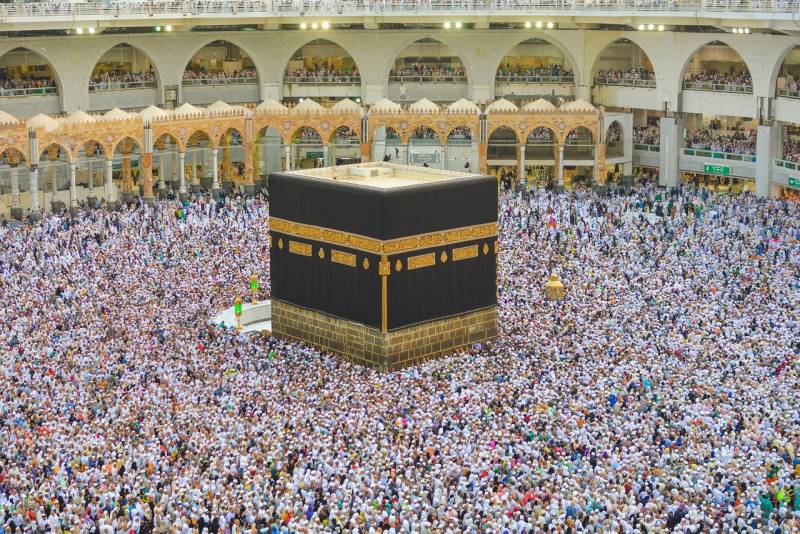Every year, countless numbers of Muslims from all over the world congregate in Mecca in preparation of the Hajj, a Muslim pilgrimage that is modelled after the activities of the Prophet Muhammad (Peace Be Upon Him).
For all financially able-bodied Muslims, participating in the six-day ceremony at least once throughout their lives is an important responsibility. Every year, between two and three million individuals perform the pilgrimage.
The Hajj takes place between the eighth and thirteenth days of the Islamic lunar calendar’s 12th month, Dhul-Hijjah, which is when the pilgrimage takes place.
Although the Prophet Muhammad’s “farewell pilgrimage” in 632 AD is where the precise rituals practised by Muslims today have their origin, annual pilgrimages to Mecca were sacred rites for Arabian tribes centuries before Islam.
According to Islamic belief, the Prophet Abraham constructed the Kaaba, a stone edifice covered in black silk at the centre of the Grand Mosque in Mecca.
Simply told, the Hajj is complicated. There are several schools of Islamic philosophy and a variety of ways to practise it, and there are significant intellectual distinctions amongst them. Here is a list of the actions involved in doing the hajj.
Ihram (Sacred cloth)
When a pilgrim crosses the Miqat, or outer bounds of Mecca, the first act of the Hajj is to enter ihram, or the holy state.
On the eighth of Dhul-Hijjah, pilgrims enter ihram, which requires them to wear simple attire—two unstitched cloths for males, or loose clothing for women—and adhere to specific regulations like not giving into anger or engaging in sexual activity.
Go to Mina, a large tent city
Then, either on foot along the roads of the pilgrims or by buses and vehicles, the pilgrims depart in great numbers from Mecca to the vast tent city of Mina. The distance is 8 kilometres.a
The pilgrims will stay in Mina for the day and leave the next morning at first light. In Mina, the majority of the time is devoted to prayer and remembering Allah.
Arafat
One of the most significant days in the Islamic calendar—and not just for the Hajj—is the Day of Arafat. The last sermon of the Prophet Muhammad was delivered on Mount Mercy in Arafat. Pilgrims arrive here from Mina after travelling 14.4 km, where they spend the day in peaceful prayer.
Many Muslims throughout the globe decide to fast on this day.
Gather stones at Muzdalifah
Following dusk, it’s time to move once more, this time travelling the 9 kilometres to Muzdalifah, where they spend the night beneath the stars. Many will also start gathering stones here in preparation for tomorrow’s rituals, leaving once more right before dawn.
For a crucial rite, pilgrims congregate at Mount Arafat.
Cast rocks at the pillars.
For those who are completing Hajj, the day is referred to as yawm-ul hajj al-akbar, and it is likely the longest and most perilous day of the trip.
Eid al-Adha, the bigger of the two Muslim festivals, is observed by Muslims worldwide on the tenth of Dhul-Hijjah.
Before daybreak, pilgrims make their journey back to Mina from Muzdalifah. When they arrive at Mina, they carry out the first rami by hurling seven stones at the biggest of the three Jamarat columns.
To reenact the tale, millions of pilgrims congregate at the Jamarat Bridge, which has the three columns that serve as the devil.
The offering must be made by the pilgrims after they have thrown their stones. To summarise the narrative, when Abraham went to offer his son as a sacrifice, he discovered that God had placed a ram there in its place.
As a result, pilgrims are required to slaughter a sheep, goat, cow, or camel, or more commonly, pay for it to be done in their place.
The pilgrims now cut their hair short or shave (men only), and take off their ihram. Many will then go to Mecca to complete the tawaf and sa’ee rituals, first circling the Kaaba seven times and then traversing the highlands of Safa and Marwa seven times.
When everything is over, they head back to their camp in Mina.
Days remaining in Mina
They will once more stone the devil metaphorically on each day, but this time they will hurl seven stones at each of the three pillars.
Now that the most challenging phase is over, pilgrims will spend the following two to three days in Mina.
The pilgrims conduct the “farewell” tawaf, or final circulation of the Kaaba, before leaving Mina and travelling back to Mecca.
The pilgrims now cut their hair short or shave (men only), and take off their ihram. Many will then go to Mecca to complete the tawaf and sa’ee rituals, first circling the Kaaba seven times and then traversing the highlands of Safa and Marwa seven times.
When everything is over, they head back to their camp in Mina.
Days remaining in Mina
They will once more stone the devil metaphorically on each day, but this time they will hurl seven stones at each of the three pillars.
Now that the most challenging phase is over, pilgrims will spend the following two to three days in Mina.
When their stay in Mina is up, the pilgrims travel to Mecca to conduct the last circle of the Kaaba, known as a “farewell” tawaf.
Hajj 2023: 160,000 aspiring pilgrims returned by Saudi Arabia













